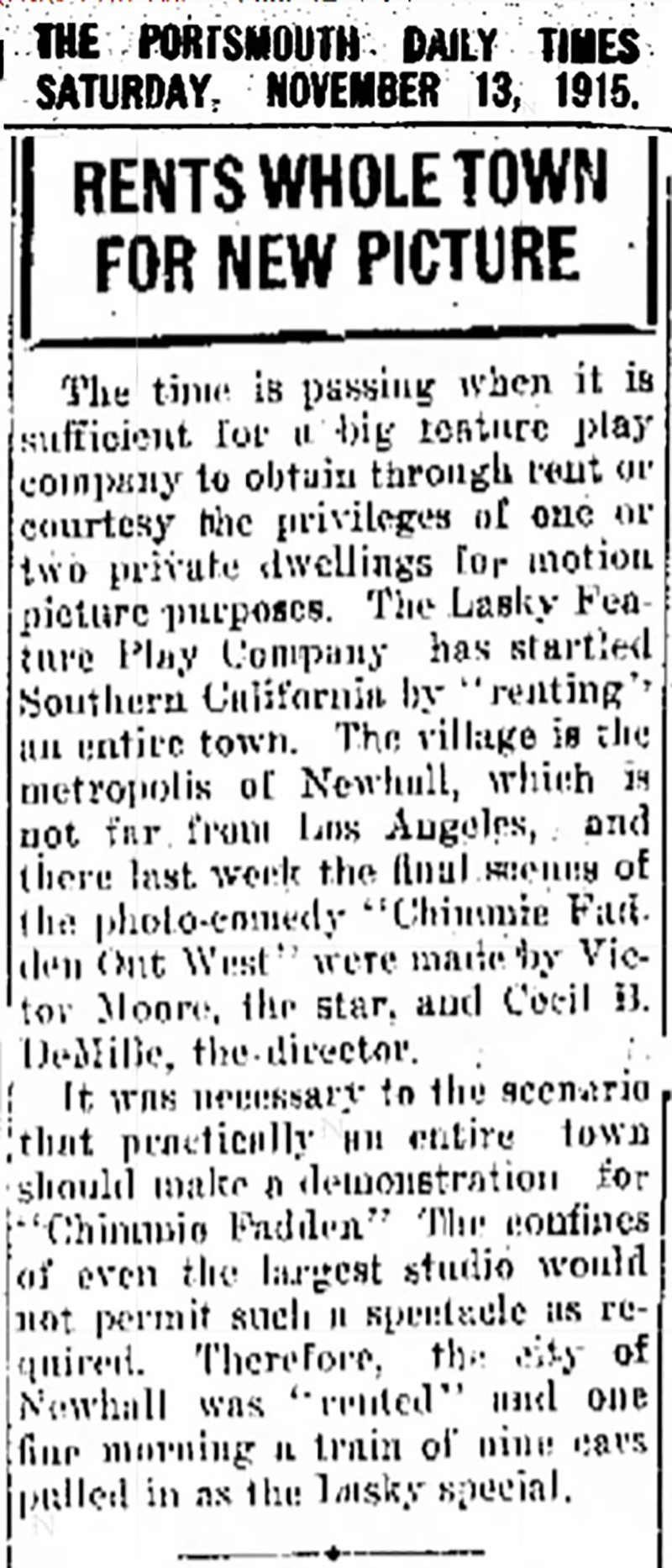"Chimmie Fadden Out West."
Movie Herald.
|
This item is intended to be viewed in Book View. Movie herald advertising Cecil B. DeMille's 1915 screen adaptation of E.W. Townsend's "Chimmie Fadden Out West." DeMille took over the entire town of Newhall to make the picture (see below). Four pages, 5½x7¾ inches. (One approx. 8½x11-inch double-sided page, folded in half.)
Synopsis. From page 4. In bringing before the photoplay public again, the popular American comedian. Victor Moore, The Jesse L. Lasky Feature Play Company presents the two of a series of comedy photoplays based on the character of E.W. Townsend's Chimmie Fadden. Mr. Moore's third Paramount Vehicle is "Chimmie Fadden Out West," said to be a fitting successor to the very entertaining production, "Snobs" and "Chimmie Fadden." Chimmie Fadden is a character of American literature likely to live as long as Tom Sawyer or other famous youths of fiction. Chimmie is city bred. He is a product of the bowery, with all the instincts and mannerisms of the city ragamuffin, whose vision of life is limited by skyscrapers and stone pavements. What happens to Chimmie when he goes to the far West, becomes a mining prospector and tries the simple life is most interestedly told in "Chimmie Fadden Out West." Mr. Cecil B. DeMille, Director General of The Lasky Feature Play Company is the producer of "Chimmie Fadden Out West." Cast: Victor Moore, Camille Astor, Ernest Joy, H.S. Hadfield, Mrs. Lewis McCord, Tom Forman, Raymond Hatton and Florence Dagmar.
Southern Californians of 1915 were "startled," the boosters declared, when Jesse L. Lasky rented "the entire town of Newhall" for the final scenes of a feature-length comedy called "Chimmie Fadden Out West," directed quite uncharacteristically by pioneer filmmaker Cecil B. DeMille. Moving-picture productions were getting so big, it was explained, the studio sets that dotted the Los Angeles area could no longer contain them. "The citizens of Newhall enjoy renting their fair city to motion picture companies," proclaimed Paramount Pictures, Lasky's exclusive distributor*, in an advertorial notice that ran in small-town newspapers. The production company rented everything in Newhall — "from the City Hall to the City Jail and including hotel, stores, railroad station and houses," along with a 9-car train. Exactly what was meant by "City Hall," we don't know; clearly, Paramount took some editorial license, going so far as to say money from filming "goes into the city strong box and helps reduce the tax rate." That might have been true if Newhall were an eastern city, but Newhall was neither eastern nor a city. No matter. Once considered lost, a print of the film turned up and has been preserved in the George Eastman House in Rochester, N.Y., so we might be able to figure out the locations one day. Perkins tells us DeMille stayed in the Swall Hotel before it burned down in 1917. It was rebuilt. "Chimmie Fadden Out West" was a 5-reel (50-minute) sequel whose release on November 21, 1915 coincided with the newspaper notices and came just five months after the release of the 4- or 5-reel original, titled "Chimmie Fadden" — a print of which exists in the Cinemateket-Svenska Filminstitutet in Stockholm, Sweden. The character, Chimmie, is the creation of author Edward W. Townsend, who penned short stories just before the turn of the 20th Century. Some of the stories were adapted to the vaudeville stage. Victor Moore evidently portrayed the title character on the stage before reprising the role in the films. It was about as unusual for a comedy to run 50 minutes in 1915 as it was for the maker of 1924's "The Ten Commandments" to direct one. "(DeMille's) vision of cinema, like D.W. Griffith's, was far more sober than that, at least in 1915," writes film historian Richard Koszarski (1990:174). "While dramatic subjects essentially abandoned shorts for features after 1915 ... relatively few feature-length comedies were produced before 1920," Koszarski notes. Audiences preferred their comedies in smaller bites, as warm-ups to the main feature on a Saturday afternoon. Both the original and the sequel co-star Raymond Hatton, who was no stranger to Newhall in later years as he starred opposite Buck Jones and Tim McCoy in the "Rough Riders" buddy pictures that filmed in Placerita Canyon in the early 1940s. Rounding out the cast are the female lead, Camille Astor; Mrs. Lewis McCord (birth name Bertha St. Clair), Ernest Joy, Tom Forman, Florence Dagmar and Harry Hadfield. DeMille is the director, producer, editor and co-writer. Cinematographer (cameraman) is Alvin Wyckoff. Death Valley locations were also used. *In 1915 the Lasky company, est. 1911, had not yet merged with Adolph Zukor's Famous Players, and Zukor had not yet bought out Paramount, with which Lasky had a distribution contract.
LW3669: pdf of original herald purchased 2019 by Leon Worden. Download individual pages here. Photo file.
|


